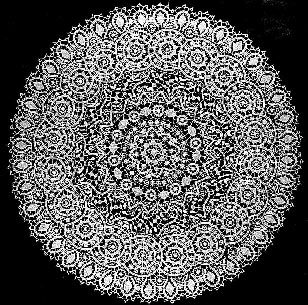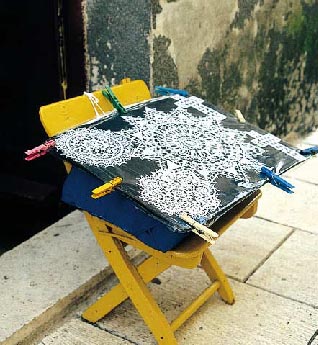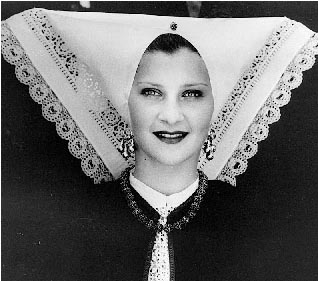 |
First the
circle is defined within which little holes are made several millimeters
apart, and then thread is pulled through them. This is how the base for
Pag lace is made it consists of eight thread sticks which are spread diagonally
across the circle. When the base is ready, small circles and triangles
(mendulice) are made from the center. When lace is created, it is firm,
as though it has been starched. Pag lace, unlike the other well-known Dubrovnik
and Lepoglava laces, can be washed without losing its firmness. Of course,
Pag lace is expensive and is, for this reason, called white gold. |
| The
diameter of a normal lace is 20 centimeters. Such lace costs from one to
two hundred German marks. However, larger lace is made to order. A piece
of lace-work with a diameter of 40 centimeters costs one thousand German
marks. Lace-work even larger than this is made by special order for those
who can pay for it. Despite its high price, Pag lace is always in demand.
During the tourist season it is always sold out, while during the year
large orders are placed. All of these are reasons explaining why the lace-making
school has been reopened and that young women are being given the chance
to learn this skill. |
|
Press Release:
The Croatian Heritage Museum and Library is pleased
to announce the opening
of its new exhibit :
Paska Cipka: Lace from the Island of Pag
"Lace is the ultimate achievement in textile art, an individual work
of
human hands made from flax, cotton, silk, agave, silver and gold threads.
Its roots, as opposed to embroidery which comes from the East, are
clearly
in the West. The material is caught, by thread, into a small, firm
construction and the architecture of air is created. The lace-maker
works
like a spider, interlacing the most imaginative stitches, the only
difference being in that work lasts, while cobwebs may be destroyed
by the
wind.
The first lace originated in the Renaissance when textiles focused
on
simplicity and purity. Lace was an ornament of both men's and women's
garments. Pag's lace originated in the same period and is Geometric
in form.
Lace making requires a needle, thread and backing which is a round
or square
shaped hard stuffed pillow. Lace-makers of Pag did their teg (work)
without
any drawings. Each woman used works from her mother and grandmothers
as
example, adding a personal touch, something unique and special. Each
lace is
a symbol of the anonymous, modest and self-sacrificing life of its
maker.
Croatia Weekly
The Croatian Heritage Museum is pleased to sponsor :
Neda Oros, from the Paska Cipka Gallery, Pag, Croatia.
Mrs. Oros will only be with us for our opening. She is bringing with
her
many fine examples of this lace. There will also be items for
sale. Please
plan to attend. We will also have taped demonstrations.
These
presentations at 2:30 and 3:45. because space is limited reservations
must
be made in advance to attend the presentations. Please call 440-327-9498
for reservations.
The exhibit will run from March 26th to September 30th , 2000.
The museum
hours are Fridays from 7 PM to 10 PM and other hours by appointment.
The
opening of this exhibit will be Sunday, March 26th from 2 to
5 PM in The
Croatian Heritage Museum located in the American Croatian Lodge Complex,
34900 Lakeshore Boulevard, Eastlake, Ohio. Also located
in this complex is
the Dubrovnik Garden Restaurant. For Group Tours and further information
please call, Suzanne Jerin at 216-991-2310. Email address
banjelacic@worldnet.att.net


